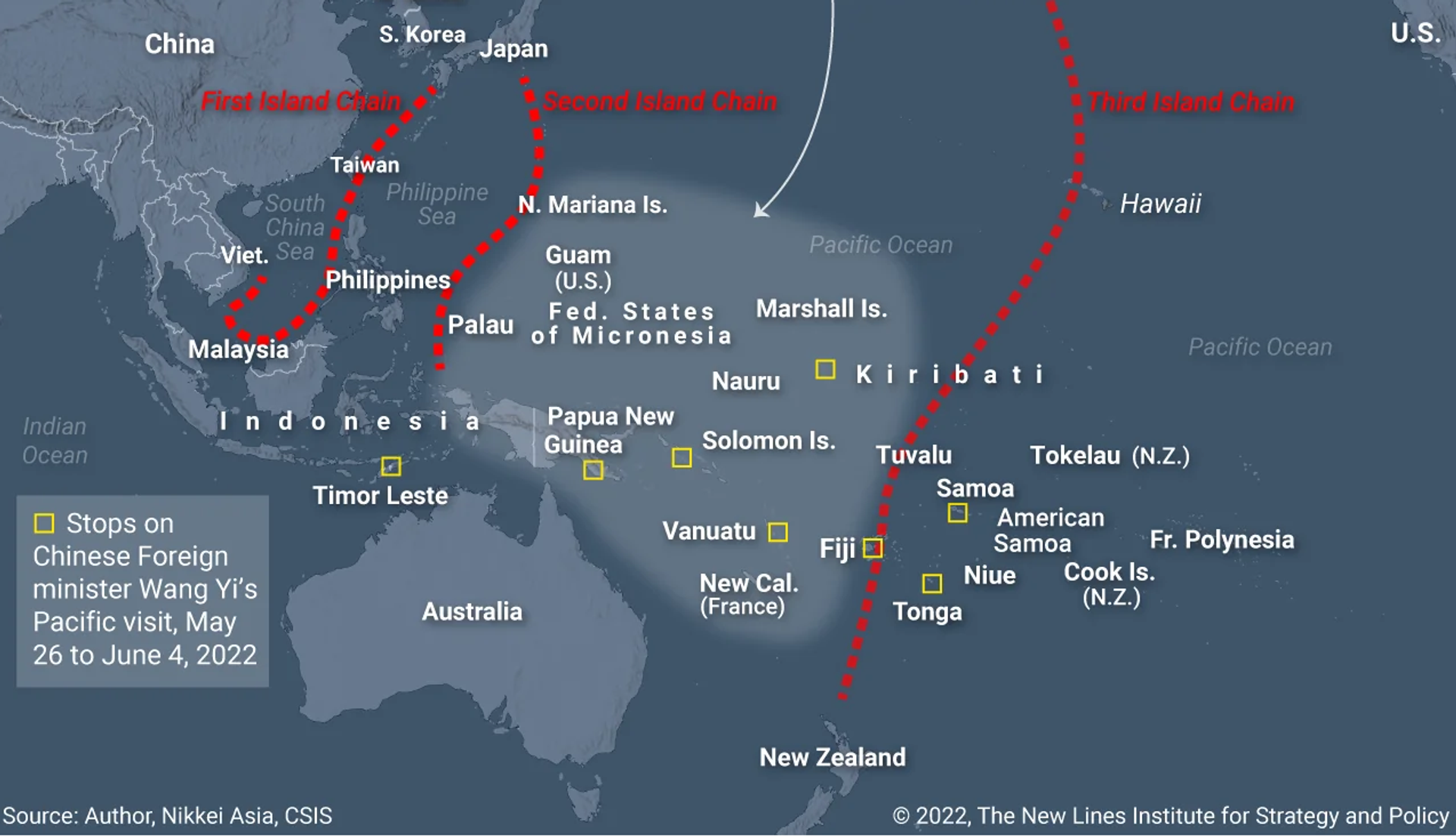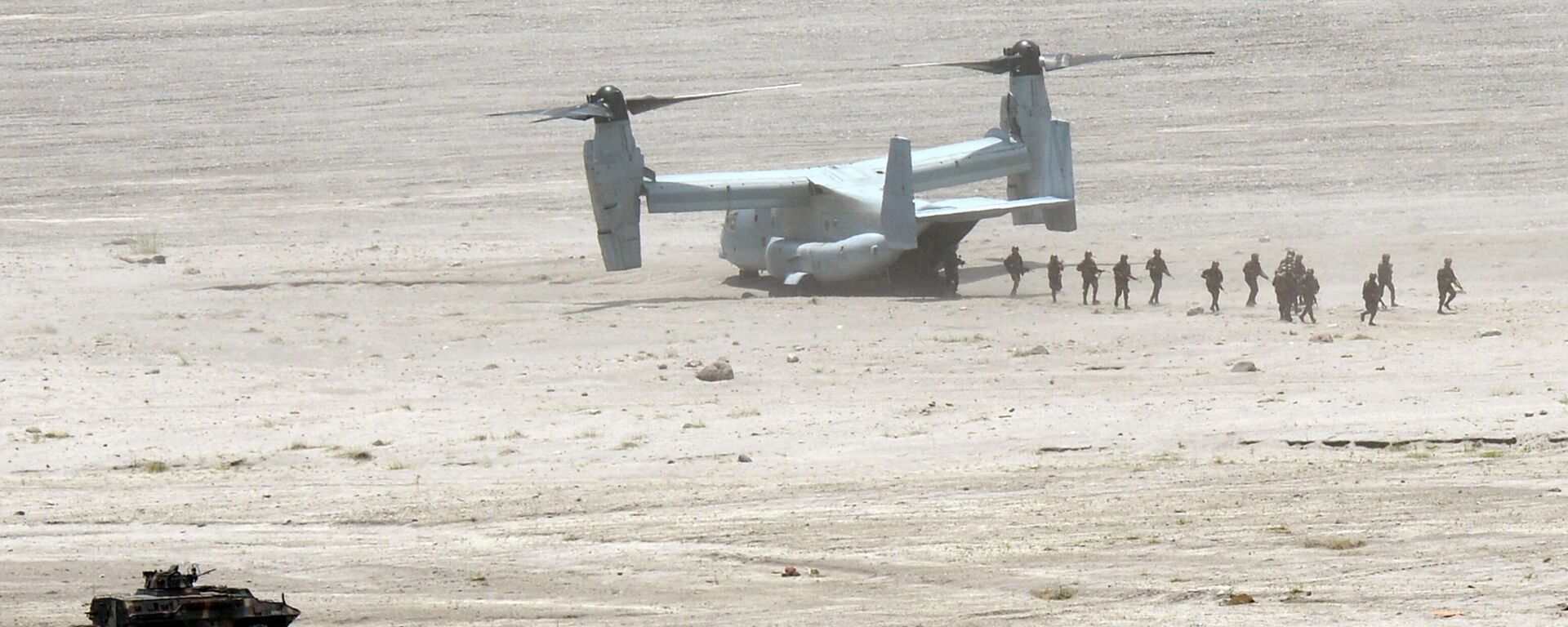https://sputnikglobe.com/20240422/southeast-asia-on-course-for-ukraine-style-crisis-amid-us-militarization-of-philippines-1118061126.html
Southeast Asia on Course to Ukraine-Style Crisis Amid US Militarization of Philippines
Southeast Asia on Course to Ukraine-Style Crisis Amid US Militarization of Philippines
Sputnik International
US and Philippine troops kicked off the largest iteration of their annual Balikatan exercises in decades this week, with this year’s drills involving some 11,000 US and 5,000 Filipino military personnel, plus forces from Australia and France. Geopolitical analyst and former US Marine Brian Berletic explains why the drills are so dangerous.
2024-04-22T17:24+0000
2024-04-22T17:24+0000
2024-04-22T17:37+0000
analysis
china
south china sea
philippines
americans
nato
navy
drills
exercise
https://cdn1.img.sputnikglobe.com/img/07e8/04/16/1118060701_0:5:3078:1736_1920x0_80_0_0_88068933ff0b1391512033ed73ed4d85.jpg
Chinese diplomatic and military officials slammed Washington and Manila over the Balikatan drills on Monday, accusing participants of attempting to “flex” their “gunboat muscles,” stoking confrontation in the South China Sea and undermining regional security.The Chinese military plans to increase its naval and air patrols in the South China Sea amid the US-Philippines exercises, which will run until May 10, and include everything from maritime security and air defense operations to cyber and information warfare, and simulate the seizure of islands in the vicinity of Taiwan and the South China Sea.Crucially, drilling will include naval exercises outside the Philippines’ internationally recognized territorial waters near the disputed South China Sea – parts of which are claimed by both Manila and Beijing.Former Philippines president Rodrigo Duterte warned current President Bongbong Marcos Jr last week about the risks of cozying up with the US at the expense of balanced relations with China, accusing Washington of trying to provoke a war between the Philippines and China, and emphasizing that he doesn’t believe “America will die for us” if tensions grow into direct clashes.Assuming office in 2022, the Marcos Jr. government moved to expand the Philippines’ Enhanced Defense Cooperation Agreement with the United States, nearly doubling the number of military bases in the country that the US gets access to from five to nine in 2023. Two of the facilities, the Antonio Bautista Air Base and the Balabac Island Air Base in the Palawan archipelago, border directly on contested waters in the South China Sea.Echoes of Ukrainian EscalationFilipinos are right to be concerned about US attempts to militarize their country, says former US Marine-turned author, journalist and independent geopolitical analyst Brian Berletic.“The Philippines were previously a US colony gaining independence only in 1945. Since then, the US has attempted to reassert political control over the country as well as maintain a large US military presence on its shores. The goal is to militarize the country and use it as part of a wider united front against China,” Berletic told Sputnik.The creeping militarization of the island nation is not unlike processes witnessed in the aftermath of the Euromaidan coup d’état in Ukraine in 2014, which were followed by joint military exercises involving US and Ukrainian troops, Berletic recalled.These processes ultimately culminated in the 2022 escalation of the Donbass crisis into a full-blown NATO-Russia proxy war.In addition to allowing the US to move its military assets “dangerously close to Chinese territory,” including in the disputed waters of the South China Sea and off the shores of the breakaway Chinese island province of Taiwan, US activities in the Philippines are designed to take advantage of and artificially inflame outstanding regional maritime disputes. This enables Washington to “both justify a larger US military presence in the region, and turn nations in the region against China,” Berletic said.South China Sea DisputeThe dispute between China, the Philippines and other nations over the strategic, energy and fishing resource-rich waters of the South China Sea dates back to the immediate post-WWII period, with Beijing staking claims on the basis of imperial dynasties’ near total control over waters in the area prior to the arrival of the Europeans and Americans in the region.America’s “national interest” in the South China Sea is also inexorably tied in part to a strategy of containing China through the so-called ‘Island Chain Strategy’, which envisions a broad network of US bases and bilateral pacts with regional powers to prevent the Chinese Navy from being able to mount operations beyond its home waters.
https://sputnikglobe.com/20240422/expansive-us-philippines-war-games-slammed-by-china-as-tension-stoking--muscle-flexing-1118052253.html
https://sputnikglobe.com/20240410/goal-of-us-drills-with-japan-australia-philippines-to-expand-nato---russia-1117845265.html
https://sputnikglobe.com/20240421/ukraine-frontline-of-wests-much-larger-conflict-with-adversaries-like-russia-china-1118042685.html
china
south china sea
philippines
Sputnik International
feedback@sputniknews.com
+74956456601
MIA „Rossiya Segodnya“
2024
News
en_EN
Sputnik International
feedback@sputniknews.com
+74956456601
MIA „Rossiya Segodnya“
Sputnik International
feedback@sputniknews.com
+74956456601
MIA „Rossiya Segodnya“
why is us militarizing philippines, will us militarization cause ukraine-style war between china and philippines, why don't china and philippines get along
why is us militarizing philippines, will us militarization cause ukraine-style war between china and philippines, why don't china and philippines get along
Southeast Asia on Course to Ukraine-Style Crisis Amid US Militarization of Philippines
17:24 GMT 22.04.2024 (Updated: 17:37 GMT 22.04.2024) US and Philippine troops kicked off the largest iteration of their annual Balikatan exercises in decades this week, with this year’s drills involving some 11,000 US and 5,000 Filipino military personnel, plus forces from Australia and France. Geopolitical analyst and former US Marine Brian Berletic explains why the drills are so dangerous.
Chinese diplomatic and military officials
slammed Washington and Manila over the Balikatan drills on Monday, accusing participants of attempting to “flex” their “gunboat muscles,” stoking confrontation in the South China Sea and undermining regional security.
“Reality has shown that those who make deliberate provocations, stoke tensions, or support one side against another for selfish gains will ultimately only hurt themselves,” Chinese Central Military Commission Zhang Youxia said, warning that US-led attempts at “maritime containment, encirclement and island blockades will only plunge the world into a vortex of division and turbulence.”
The Chinese military plans to increase its naval and air patrols in the South China Sea amid the US-Philippines exercises, which will run until May 10, and include everything from maritime security and air defense operations to cyber and information warfare, and simulate the seizure of islands in the vicinity of Taiwan and the South China Sea.
Crucially, drilling will include naval exercises outside the Philippines’ internationally recognized territorial waters near the disputed South China Sea – parts of which are claimed by both Manila and Beijing.
Former Philippines president Rodrigo Duterte warned current President Bongbong Marcos Jr last week about the risks of cozying up with the US at the expense of balanced relations with China, accusing Washington of trying to provoke a war between the Philippines and China, and emphasizing that he doesn’t believe “America will die for us” if tensions grow into direct clashes.
“I would remove the bases. And I would tell the Americans, you have so many ships, so you do not need my island as a launching pad or a launching deck for you,” Duterte
said.
Assuming office in 2022, the Marcos Jr. government moved to expand the Philippines’ Enhanced Defense Cooperation Agreement with the United States,
nearly doubling the number of military bases in the country that the US gets access to from five to nine in 2023. Two of the facilities, the Antonio Bautista Air Base and the Balabac Island Air Base in the Palawan archipelago, border directly on contested waters in the South China Sea.
Echoes of Ukrainian Escalation
Filipinos are right to be concerned about US attempts to militarize their country, says former US Marine-turned
author, journalist and independent geopolitical analyst Brian Berletic.
“The Philippines were previously a US colony gaining independence only in 1945. Since then, the US has attempted to reassert political control over the country as well as maintain a large US military presence on its shores. The goal is to militarize the country and use it as part of a wider united front against China,” Berletic told Sputnik.
“Exercises like Balikatan give the US an opportunity to shape the Philippines’ armed forces into a suitable proxy for a potential conflict with China,” the observer warned.
The creeping militarization of the island nation is not unlike processes witnessed in the aftermath of the Euromaidan coup d’état in Ukraine in 2014, which were followed by joint military exercises involving US and Ukrainian troops, Berletic recalled.
These processes ultimately culminated in the 2022 escalation of the Donbass crisis into a full-blown NATO-Russia proxy war.
“Washington’s primary objective in the Asia-Pacific region is to encircle and contain China. To do this, the US is attempting to compromise the governments of nations along China’s periphery including the Philippines, establish a US military presence within their borders, and militarize these countries against China,” the observer explained.
In addition to allowing the US to move its military assets “dangerously close to Chinese territory,” including in the disputed waters of the South China Sea and off the shores of the breakaway Chinese island province of Taiwan, US activities in the Philippines are designed to take advantage of and artificially inflame outstanding regional maritime disputes. This enables Washington to “both justify a larger US military presence in the region, and turn nations in the region against China,” Berletic said.
“This will result in a similar crisis as seen in Europe where the US not only used Ukraine in a highly destructive proxy war against Russia, but also decimated Europe’s economy, socio-political stability, and placed the entire region on the precipice of a US-driven war,” Berletic fears.
The dispute between China, the Philippines and other nations over the strategic, energy and fishing resource-rich waters of the South China Sea dates back to the immediate post-WWII period, with Beijing staking claims on the basis of imperial dynasties’ near total control over waters in the area prior to the arrival of the Europeans and Americans in the region.
China has been exploring a regional dispute mechanism with its South China Sea neighbors since 2002, and has called on Washington – which has no claims to the region, to butt out. The US has gradually ramped up its military presence in the region since the early 2010s, when Obama Secretary of State Hillary Clinton called the South China Sea a matter of US “national interest.” In addition to shoring up a network of alliances and undermining Chinese negotiating efforts, the US has deployed Navy and Coast Guard ships into the South China Sea on so-called ‘freedom of navigation’ missions to challenge Chinese sovereignty claims. These missions have resulted in a series of close calls between Chinese, US and US-allied warships and military aircraft.
America’s “national interest” in the South China Sea is also inexorably tied in part to a strategy of containing China through the so-called ‘Island Chain Strategy’, which envisions a broad network of US bases and bilateral pacts with regional powers to prevent the Chinese Navy from being able to mount operations beyond its home waters.








